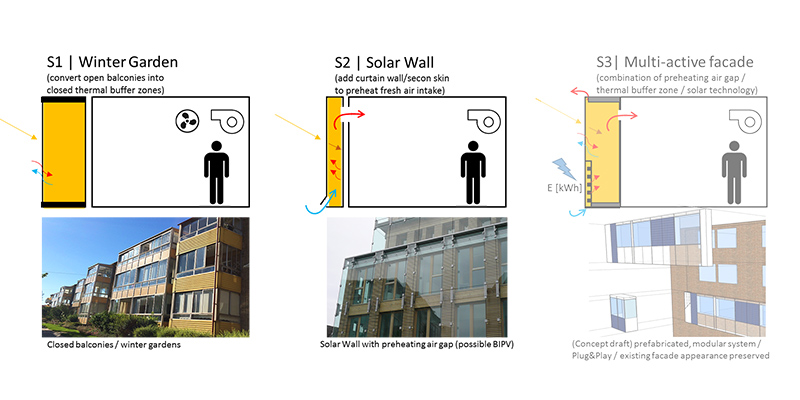Downloads
DOI:
https://doi.org/10.7480/jfde.2017.1.1425Keywords:
multifunctional façade, multi-active façade, energy renovation, multi-family buildings, passive measures, SwedenAbstract
In order to meet the Swedish energy efficiency objectives for the built environment until 2050, a particular building stock has to be addressed: the houses of the Million Homes Programme, an ambitious housing programme of the 1960s and 70s that resulted in a large number of standardized multi-family houses all over Sweden. These are in need of upgrading the energy and comfort quality to current standards, which provides an excellent opportunity to investigate the potentials of ‘prefabricated multi-active’ façades for refurbishments on large scale. While ‘prefabrication’ is linked to cost-effectiveness and high replicability, ‘multi-active’ addresses the potential of embedded active and passive measures for improved energy efficiency and energy regulation out of the façade. Integrated building services technologies, solar technologies or moveable components, such as shading systems, are considered active measures. Passive measures include physical and constructive measures, such as e.g. thermal insulation or selective coatings of glazing’s, and provide a “passive” energy flow control to improve the thermal quality of the building envelope. Many of these strategies are well-known, traditional solutions. Although they do not provide an energy-generating or -supplying function, they dynamically interact with environmental changes; preheating of supply air through the air cavity of a façade construction or adaptive thermal buffer zones are just few of many examples. The question is how traditional passive strategies can be used to contribute most effectively to the demanded energy efficiency. The paper presents first results from an assessment dealing with this question: Two traditional ‘passive’ façade strategies, a curtain wall system and closed balconies, have been analysed in regards to their impact on energy balance and their thermal behaviour in a defined renovation scenario. The assessment is aims to support the development of a multi-active facade concept suitable for large-scale refurbishments of the multi-family houses in Sweden, which is part of the initial phase in the pre-study “Multi-active façade”. The pre-study considers architectural, technological and constructive aspects, energy performance and indoor comfort optimization, but also economic feasibility and constraints to get replicable on large scale. So-called added values that concern the upgrade to modern living standards and expectations by inhabitants and the market value of the building are also touched. The paper discusses, based on a technology screening to identify suitable key measures, the energy saving potential and impact on thermal indoor comfort of two passive renovation strategies for facades.
How to Cite
Published
Issue
Section
License
Copyright (c) 2017 Susanne Gosztonyi, Magdalena Stefanowicz, Ricardo Bernardo, Åke Blomsterberg

This work is licensed under a Creative Commons Attribution 4.0 International License.
Authors or their institutions retain copyright to their publications without restrictions.
References
BBR. (2015, 05). Regelsamling for byggande, BBR 2015. Retrieved from Boverket: http://www.boverket.se/globalassets/publikationer/dokument/2015/regelsamling-for-byggande-bbr-2015.pdf
BeBo. (2014, 09). Halvera Mera – Förstudierapport för kv Sloalyckan, Falkenbergs Bostads AB. Retrieved from BeBo: http://www.bebostad.se/wp-content/uploads/2014/09/Falkenbergs-bostads-AB.pdf
Bernardo, L. R., Hadzimuratovic, A., Swedmark, M., Burke, S., Nilsson, T., Gosztonyi, S., & Blomsterberg, A. (2016). Prefabricated multi-active facade elements for energy renovation of multi-family houses - a theroretical case study in Sweden. 4th IAHS World Congress - Sustainability and Innovation for the Future. Lissabon.
Boverket. (2012, 08). Handbok för energihushållning. Retrieved from Boverket: http://www.boverket.se/globalassets/publikationer/dokument/2012/handbok-for-energihushallning-enligt-boverkets-byggregler.pdf
BPIE. (2016, 02). Prefabricated systems for deep energy retrofits of residential buildings. Retrieved from BPIE Buildings Performance Institute Europe: http://bpie.eu/wp-content/uploads/2016/02/Deep-dive-1-Prefab-systems.pdf
Climate-Data. (2016, 06 20). Falkenberg, Sweden. Retrieved from climate-data.org: http://en.climate-data.org/location/9516/
EU EPBD. (2010, 06 18). Directive 2010/31/EU on the energy performance of buildings (EPBD). European Parliament and EU Council.
FEBY 12. (2012, 01). Kravspecifikation för nollenergihus, passivhus och minienergihus - bostäder. Retrieved from Sveriges cebtrum för Nollenergihus: http://www.nollhus.se/dokument/Kravspecifikation%20FEBY12%20-%20bostader%20sept.pdf
Hall, T., & Vidén, S. (2005). The Million Homes Programme: a review of the great Swedish planning project. Planning Perspectives, 20, 301-328.
Högberg, L., Lind , H., & Grange, K. (2009). Incentives for Improving Energy Efficiency When Renovating Large-Scale Housing Estates: A Case Study of the Swedish Million Homes Programme. Sustainability, 1349-1365.
IDA ICE, EQUA. (2016, 08 16). IDA Indoor Climate and Energy. Retrieved from EQUA Simulation AB: http://www.equa.se/en/ida-ice
Johansson, N., & Karlsson, J. (2015). Economic Feasibility for Solar PV in Swedish Office Buildings. A Case Study Approach. Göteburg: Chalmers University of Technology, Thesis.
